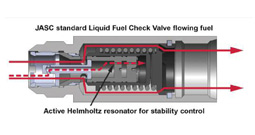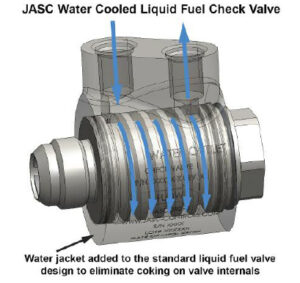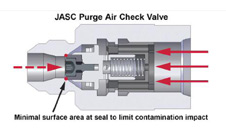
This article originally appeared in the July 2009, Modern Power Systems Turbine Technology Directory.
Utilizing the appropriate liquid fuel and purge air check valves will provide a level of operational capability which can exceed 95% availability and reliability; a number far better than the typical 35 to 40% foremost dual fuel applications. More importantly, these modifications can yield the same outstanding results no matter the age or size of the turbine.
Over the past 30 years, utilities have paid millions of dollars in additional cost when purchasing turbines which have dual fuel capability or the ability to operate on both natural gas and liquid fuel. A comprehensive solution was only developed relatively recently.
 The liquid fuel check valve is the first component which should be addressed when seeking to improve fuel system reliability. Two key characteristics of the design should be passive dampening and active cooling. These features address the most common failure modes which have been seen over the past couple of decades. High-frequency oscillation or chatter in the check valve is the result of pulsations from the flow divider which excite the check valve when the resonant frequency of the check valve spring is reached. The reaction of the check valve can be extremely violent. Hydraulic hammer associated with the rapid opening and closing of the check valve can actually cause the fuel tubing to break. The passive dampening feature attenuates the pressure signature of the flow divider output, eliminating the chatter and premature wear of the check valve internals which causes the loss of sealing capability. While this design feature has been available for at least 10 years, the stability which ensued after its implementation created an ideal environment for another failure mode: coking.
The liquid fuel check valve is the first component which should be addressed when seeking to improve fuel system reliability. Two key characteristics of the design should be passive dampening and active cooling. These features address the most common failure modes which have been seen over the past couple of decades. High-frequency oscillation or chatter in the check valve is the result of pulsations from the flow divider which excite the check valve when the resonant frequency of the check valve spring is reached. The reaction of the check valve can be extremely violent. Hydraulic hammer associated with the rapid opening and closing of the check valve can actually cause the fuel tubing to break. The passive dampening feature attenuates the pressure signature of the flow divider output, eliminating the chatter and premature wear of the check valve internals which causes the loss of sealing capability. While this design feature has been available for at least 10 years, the stability which ensued after its implementation created an ideal environment for another failure mode: coking.
 Active cooling is the next key characteristic which is required for a liquid fuel check valve design. Keeping the valve internals below the threshold which allows the formation of coke ensures that a Class 6 seal is maintained in the checked and reverse flow direction from hot gas path inspection to hot gas path inspection. The absence of coke formation also enhances the ability to start the turbine on liquid fuel and to transfer back and forth between fuels because the check valves are able to maintain the same cracking pressures. While this technology has only been available since 2005, it has accumulated over two million hours of successful operation in
Active cooling is the next key characteristic which is required for a liquid fuel check valve design. Keeping the valve internals below the threshold which allows the formation of coke ensures that a Class 6 seal is maintained in the checked and reverse flow direction from hot gas path inspection to hot gas path inspection. The absence of coke formation also enhances the ability to start the turbine on liquid fuel and to transfer back and forth between fuels because the check valves are able to maintain the same cracking pressures. While this technology has only been available since 2005, it has accumulated over two million hours of successful operation in
worldwide turbine applications. Specifically, turbines utilizing this technology have demonstrated the ability to service these valves at hot gas path inspections.

The purge air check valve is the second component which should be addressed. The design should be contamination tolerant, chatter resistant and provide a Class 6 seal in the reverse flow direction. Given the low force margin which is required for opening the valve, less than 1 psi, the check valve design should incorporate a knife edge seat to improve its tolerance to contamination. The purge air check valve design should also provide a toggle action when opening and closing. This feature prevents the check valve from experiencing high frequency oscillation and premature wear of the valve internals. Vibration of the turbine during operation coupled with the low force of the purge air system also dictates that a toggle action design be used. The absence of wear due to chatter ensures that the valve will be capable of sealing against fuel oil in the reverse flow direction when the turbine is operating on liquid fuel.
In conclusion, implementation of water-cooled liquid fuel check valves and purge air check valves can provide tremendous advantages for dual fuel gas turbines of any age. As gas turbine designs have a wide variety of configurations for the liquid fuel, purge air and water injection systems, we recommend that you contact JASC for details on how these designs can be used to benefit your specific application.
